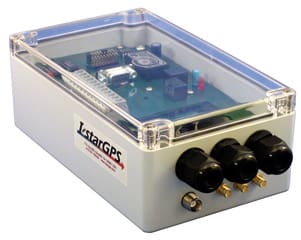One look at the new IstarGPS HSM-104 GPS receiver from Farallon Electronics can evoke memories of 1987. Back to a time when a GPS receiver was the size of a microwave and had only one channel for listening to the signals from GPS satellites.
Not that the HSM-104 is old technology. In fact, it is just the opposite, this is a cutting-edge GPS devised by a group of West Coast sailboat racers and technology experts who wanted to come up with the ultimate high-performance GPS. The HSM-104 has more sophisticated signal-processing technology and networking capability than that found on most GPS units sold to recreational mariners.
The look and feel of the product, however, is drastically different from the sleek, miniaturized GPS units now offered by the top marine electronics companies. The HSM-104 has a geeky, grad student vibe that recalls the early days of GPS, when the biggest issues where 1) how many channels a unit had (most had only one, dual channel units were a big deal) and 2) finding room at the nav station for a big marine electronic.
By the mid ’90s, GPS receivers had multiple channels and had slimmed down to the point that they easily fit in the nav station. But it is very much the “black box€VbCrLf form of the HSM-104 that explains its high-end performance. It is equipped with a sensitive 16-channel GPS engine made by the chip company Atmel, which supplies single and dual-chip GPS engines for a variety of applications. This Atmel GPS engine is noted for its sensitivity. According to Farallon, the unit can grab GPS signals at -158dBml; a level that Farallon claims is roughly 10 times better than the HSM-104’s competitors.
And the HSM-104 has impressive networking capabilities, with four independently configuable NMEA output ports that can drive up to 12 devices at baud rates up to 38,400. The unit can also send NMEA data via Ethernet User Datagram Protocol (UDP, a transport protocol for short data messages that uses less handshaking and error correction than Transmission Control Protocol, commonly used for Internet data communications). This allows Istar GPS data to be sent via Ethernet to a PC without the need for a USB or serial port connection.
Another area where the HSM-104 is reminiscent of 1987 is its use of MotionSense technology. This is a sophisticated feature that produces nearly instantaneous velocity and course data. In fact, MotionSense is so high end that it has generally been used only in expensive survey-quality and military GPS units.
If MotionSense is that good, how is it anything like 1987? The answer lies in the technique used. MotionSense looks at the Doppler shift of the GPS carrier frequency as it arrives at the receiver from each satellite. Doppler shift, of course, is the frequency shift imparted on the transmissions from an object that is moving relative to you – whether those transmissions consist of sound, radio waves or light. The received frequency is shifted higher as the object approaches and then lower as it recedes. The Doppler shift of radio waves was the primary technique employed in a radionavigation system widely used in 1987: The Navy’s Transit system (popularly referred to as SatNav). A Transit receiver tracked the signal from a polar orbit satellite as it passed. By sensing the Doppler shift of the signal and given the knowledge of the satellite’s orbit (broadcast by each satellite), the receiver could determine its position.
Somewhat like Transit, MotionSense technology uses the Doppler shift of GPS signals to determine changes in the velocity of your vessel. One advantage to this method is that it is extremely fast and it provides an instantaneous reading. Most recreational GPS units determine speed over the ground (SOG) and course over the ground (COG) by determining a series of positions and then averaging them over time, much the same way a loran receiver used to determine vessel speed. According to Farallon, the HSM-104’s MotionSense COG/SOG is precise to 0.1 knot and responds within one second.
The team behind the IstarGPS HSM-104 includes Eric Steinberg, Stan Honey, Matt Wachowicz and Mark Rudiger. Steinberg has a marine electronics background and is a principle of Farallon Electronics – which is the U.S. importer for the Pactor brand of HF radio modems made by the German company SCS. Honey, Wachowicz and Rudiger are all experienced sailboat racing navigators. Honey is an electrical engineer who has been associated with a number of Silicon Valley start-ups, such as Etak, an early car navigation effort, and Sportvision, the company that improves television sports with digital enhancements like the yellow first down line used in football broadcasts.
According to Steinberg, he and Honey, Wachowicz and Rudiger have talked about putting together a high-end GPS. This year’s Bermuda Race prompted them to action. “We’ve known for a while there are chipsets available that can do better course over ground and speed over ground,€VbCrLf said Steinberg. “We wanted something that would allow a navigator to look at Gulf Stream current with more instantaneous results.€VbCrLf And if you can determine Gulf Stream currents, then you can determine the effect of just about any current – highly useful data when racing.
If you want the ultimate GPS for sailboat racing, the HSM-104 is for you. Just be prepared to spend a bit more than for a handheld Garmin. The price for the basic version of the HSM-104 is $1,895. Farallon expects to ship units before the end of the year.

